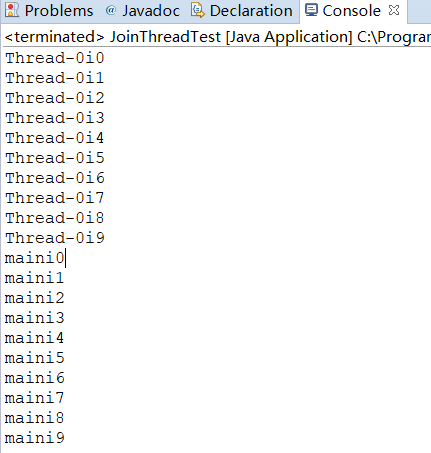当在主线程当中执行到t1.join()方法时,就认为主线程应该把执行权让给t1
废话不多说看代码:
package com.toov5.thread; public class JoinThreadTest { public static void main(String[] args) { Thread t1 = new Thread(new Runnable() { @Override public void run() { for(int i=0;i<10;i++){ try { Thread.sleep(1000); } catch (Exception e) { // TODO: handle exception } System.out.println(Thread.currentThread().getName()+"i"+i); } } }); t1.start(); //主线程在此调用t1.join()方法,就认为主线程应该把执行权交给t1 让t1执行完毕后再执行主线程 try { t1.join(); } catch (InterruptedException e1) { // TODO Auto-generated catch block e1.printStackTrace(); } // t1.start(); for(int i=0; i<10;i++){ try { Thread.sleep(10); } catch (InterruptedException e) { // TODO Auto-generated catch block e.printStackTrace(); } System.out.println("main"+"i"+i); } } }
如果先调用join的方法在执行 启动线程
package com.toov5.thread; public class JoinThreadTest { public static void main(String[] args) { Thread t1 = new Thread(new Runnable() { @Override public void run() { for(int i=0;i<10;i++){ try { Thread.sleep(1000); } catch (Exception e) { // TODO: handle exception } System.out.println(Thread.currentThread().getName()+"i"+i); } } }); // t1.start(); //主线程在此调用t1.join()方法,就认为主线程应该把执行权交给t1 让t1执行完毕后再执行主线程 try { t1.join(); } catch (InterruptedException e1) { // TODO Auto-generated catch block e1.printStackTrace(); } t1.start(); for(int i=0; i<10;i++){ try { Thread.sleep(10); } catch (InterruptedException e) { // TODO Auto-generated catch block e.printStackTrace(); } System.out.println("main"+"i"+i); } } }
结果分别:

和
